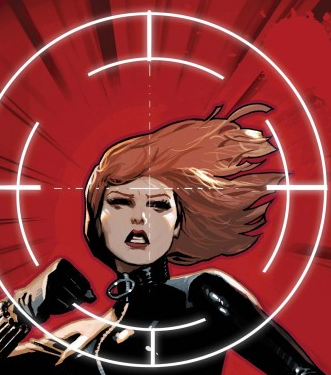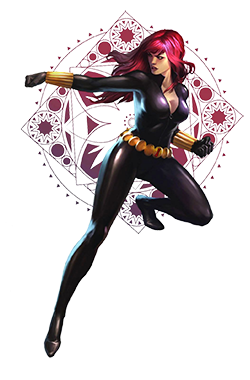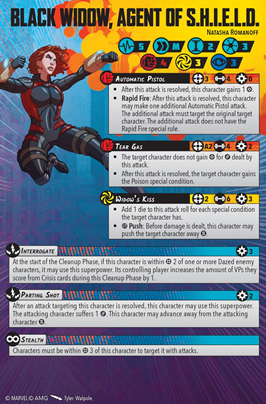
Whether it is The Dread Dormammu or The Dreaded Stark, there’s no character in the Marvel Crisis Protocol Universe which fails to send a shiver down the spine of their enemies… at least some of the time. Today let’s look at The Dreaded… Black Widow, Agent of Shield!

Welcome to the second in a series of articles I am putting together to draw attention to some characters and their unique interplay within Marvel Crisis Protocol. With over 100 characters either in the game, all of which can play under the 25 (!!) leaderships currently available, there’s a truly vast number of different combinations which provide huge variety in the play experiences on the table before even a single die is rolled.
We’ll be looking at a character I love – and not just because she is the first conversion I have done for Marvel Crisis Protocol.


The first character in the game to have two variants, Agent Widow is a notable departure from her 2-threat version. Xavier Protocols did a fantastic article breaking down the character’s attacks and superpowers, so I won’t retread too much of that ground here.
As time has gone on, though, Agent Widow has found herself in a new world – one where there is much more competition for the coveted 3 threat slot, true, but also one in which I think we can see her abilities in a whole new light.
Firstly, it is worth looking at where Agent Widow is affiliated. As well as Avengers, which have two new leaders in the form of Captain America (Sam Wilson) and Hulkbuster, she is now also affiliated in A-Force.
Sam Wilson generally wants to run a lot of 3 threat bodies, and there are many fantastic options in Avengers. Counterintuitively, the better the rest of her team is, the better Agent Widow becomes in comparison. Let me explain.
Whilst Agent Widow isn’t a terrible character on – with rapid fire to help her gain power, a cheap area attack which hands out poison, and a cheap energy attack which has a wild push regardless of size, it would be difficult to ever call her truly bad – what makes her shine is her Interrogate ability.
If she has 3 power at the clean-up step and you are scoring even a single point from one of the Crisis cards, she can score you an extra victory point if she is within range 2 of a dazed character. This is not guaranteed to trigger by any means, but it is a constant threat hanging over your opponent which they must be aware of. Gaining an extra victory point can negate the advantage that an opponent had worked to achieve, or even tip the scales decisively in your favour.
What makes Agent Widow interesting as a character is that this threat doesn’t need to ever actually happen to impact the game. By taking her, you force the opponent to deal with her and not the rest of your team. If they ignore her and focus on attacking your heavy hitting pieces then so long as she has 3 power and can get into range she can score you a victory point. If they come to attack her, though…
Well, Agent Widow has a kit which makes it really annoying to do that! Enemy characters have to move within 3 of her thanks to Stealth, and if they don’t daze her in one attack she can spend 2 power to advance short away and do a point of damage right back, forcing them to chase her down again rather than be able to attack her twice.
For these reasons I think she makes an excellent consideration in A-Force. She-Hulk is a character that requires your opponent to commit heavily if they want to take her out. If they don’t, or even if they do but don’t manage to do so very quickly, she’s likely to daze at least one attacker on the way down.
If they do focus on She-Hulk, her leadership can get Agent Widow to the power she needs to Interrogate very early in the game, and it is highly likely that She-Hulk will be able to daze at least one opponent on the way down even in the very worst case scenario.
Meanwhile, if they focus on Agent Widow, she is doing what she does best: drawing fire away from the rest of the team. A-Force doubles down on how frustrating it can be when she escapes with minimal damage because if she takes just 1 or 2 points, she can deal a guaranteed point back to the character attack her and give a power out to one of your other power hungry characters.
A-Force Assemble can also help make sure that Agent Widow survives a pivotal turn if she’s in the thick of things. She far prefers to be out on a wing forcing an enemy character to chase her down; but it’s equally entertaining when someone swings at her, fails to do any damage, and takes a point of damage themselves for their trouble. A-Force can help keep her loaded on power to do that and still have the freedom to move in and interrogate if possible.
There’s some great synergy in Avengers too of course. Steve Rogers reduces the cost of Parting Shot by 1 which is a nice quality of life improvement, but importantly he doesn’t reduce the cost of Interrogate, and there are probably better people to pair with Steve to make the most out of that leadership.
Sam Wilson is a good choice. He lets Agent Widow get a small move if someone else on the team gets dazed – potentially moving her into range of a character who is (or is likely to be) dazed unexpectedly even after she’s activated. I think she is best used, though, when she’s paired up with a huge threat that your opponent wants to focus on.
For me, the characters that jump out within Avengers here are Hulk, Hulkbuster, Scarlet Witch and Doctor Voodoo. All of these characters have huge threat potential, and your opponent can feel obligated to put a lot of effort into taking them out of the game for fear of letting them run riot through their team. Scarlet Witch and Doctor Voodoo are particularly interesting here because they are a little bit easier to take out than Hulk or Hulkbuster, and therefore the opponent will be even more tempted to try and do it early.
Running Agent Widow alongside them, your opponent is now faced with an unenviable choice: do they attack Scarlet Witch or Voodoo, or do they send someone after Agent Widow to try and take her out instead. Every model they send after Agent Widow is one who isn’t going into your bigger, more threatening piece – and if they don’t succeed, you are very likely to have someone who Agent Widow can run in and interrogate at the end of the round.
Agent Widow does have some downsides though. With only 4 die on her builder and area attack, and only 6 on her spender (unless you have loaded the opponent up with status effects) she can struggle to secure damage. I don’t often see her attacks as a way to actually do damage; she wants to use her automatic pistols to build power, her tear gas to hand out poison (which honestly is rarely a priority to cause), and her Widow’s Kiss to push an opponent who wasn’t expecting it (there’s little funnier than giving Dormammu a sudden shock).
Luckily, there are some ways to counteract that weakness.
Hawkeye – who comes in the same pack as her which is always nice – is a great support piece for his teammate. He can put out 4 different conditions to help power up her Widow’s Kiss, he has the range to support her from afar so the character chasing her down may have a difficult time attacking both, and together they have access to the Professionals tactics card.
This one is a bit of a niche case. It costs 2 power from both characters and if Hawkeye deals damage to a character that is within 2 of Agent Widow you move one asset or civilian token from the damaged character to her. If the situation is just right, this can potentially mean moving two tokens to Agent Widow – which can be huge! But it does rely on Hawkeye doing at least 1 point of damage on each attack, and as he’s only throwing 5 dice that is far from a given.
Nevertheless, even the threat of it plays into the gameplan of having Agent Widow draw focus from your bigger pieces. Allowing her to be a more power efficient version of Black Cat or Enchantress for one round is huge, even if your opponent is likely to have a window of opportunity to try and hit Agent Widow when she’s just holding the objectives and hasn’t run away yet. It can make attacking Widow go from something that they might be thinking about, to something that they have to do or risk losing the game. The ideal is probably that Hawkeye dazes the target Widow is next to and then she is free to interrogate them, securing 2-3 victory points.
Blind Obsession can also be a great card for Agent Widow. If you’ve succeeded in drawing just one opponent away from the main fight to try and take her out in a 1 v 1 scenario, Blind Obsession costs the 3 power that you would otherwise have been using to threaten Interrogate, and it heavily tilts most fights in her favour. Suddenly, Agent Widow has a 6/5/5 defensive statline and can throw out up to 4 6 die physical attacks each round at the unfortunate target she is locked in combat with. If your opponent has committed a character like Zemo or Valkyrie to try and take her out cheaply and efficiently, this can force them to reassess whether they have committed enough to that battle and put the pressure on them to put another character in the fight – or risk the worst of both worlds as Agent Widow takes out the person sent to hunt her down and interrogates them on the way out!
The last thing I think it is worth drawing attention to is the fact that if she doesn’t have a good daze target, Agent Widow can gain power surprisingly quickly. 2 power per attack action makes her a very efficient battery.
This makes it very tempting to take Field Dressing, Patch Up and Helios Laser Bombardment with her.
This way, even if your opponent succeeds in keeping the Interrogate from happening, she can still have a useful outlet for her power. Field Dressing and Patch Up pair particularly well if you see her main utility in keeping your big pieces around longer.
There are of course some more synergies that I haven’t explored in detail. Agent Widow’s area effect poison can nicely set up Omega Red to run in and do some guaranteed damage. She may also play nicely with teams who largely avoid doing damage but hope for one big turn where they can knock down a few key pieces – such as Web Warriors. On paper I think she also looks interesting next to Ghost Rider – who punishes people for attacking her, whilst if they attack him, they leave themselves open to her scoring that all important point. And of course, we’re soon to have a S.H.I.E.L.D affiliation, where I’d be shocked if she doesn’t have a new home. It’ll be interesting to see if any of the tactics cards for that affiliation open up new lines of play for her!
In conclusion, your opponent should dread Agent Widow if…
- You have a lot of targets they want to take out quickly and she isn’t one of them.
- They don’t have enough models to send someone after her on their own.
- You have the final activation so can run Agent Widow in uncontested.
- You have a card slot for Professionals and it is likely to come up.
- You are bringing lots of status effects (Hawkeye, Scarlet Witch).
But perhaps Agent Widow should dread games where…
- You are going to have a tough time dazing pieces (lots of high health, invulnerable targets).
- You need to be contesting points with lots of bodies.
- There are not many extracts on the board.
- You need every piece doing a lot of damage and you can’t bring Blind Obsession.
- There’s fast-moving, hard-hitting pieces who can hunt you down with less effort (Ghost Rider, Angela)
That’s Agent Widow. A very technical piece and one which relies on being able to judge your opponent’s intentions and strategy correctly, but also one that asks a question that no other piece in Marvel: Crisis Protocol asks: How much effort is it worth putting in to stop an opponent scoring a victory point?
Do you have a character you’d like to understand why you or your opponents should dread? Please feel free to send an email over to ADreadedGoose@gmail.com and perhaps I can help!

